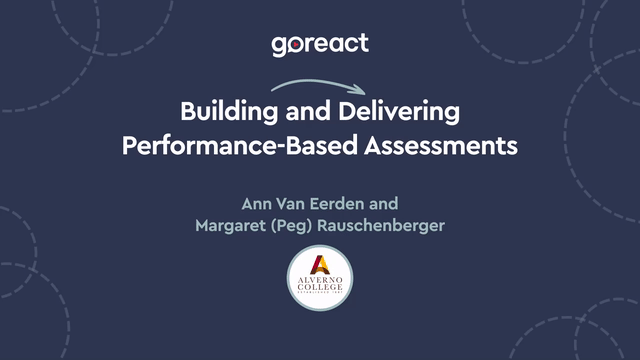
- Higher Education
- K12
- Professional
- Pricing
- Resources
-
-
-
CONTENT TYPE
-
-
-
NEW FEATURE
-
-
-
-
- Login
- Global
- CONTACT SALES EXPLORE GOREACT
Nursing Education
A short video clip about how to formulate assessments that set and monitor progress toward learning goals

See how assessment of, for, and as learning has benefited nursing students at Alverno College as well as faculty who can identify what’s working (and what’s not) and adjust teaching strategies to build competencies.
Ann VanEerden:
At Alverno college, our approach to assessment really hasn’t changed because this is what we’ve always done since the early 1970s. We look at assessments in a variety of different ways, not a test, right? Okay, so we look first there’s assessment of learning, and this is a standard space measurement for accountability, certification, progression. NCLEX is an example of assessment of learning. Second, we look at assessment for learning, and these are diagnostic measurements used to provide developmental feedback to the learner and to the teacher. And then lastly, we look at assessment as learning, and this is a metacognitive process whereby self-assessment, and peer feedback, and instructor feedback are used to help students set and monitor progress toward learning goals. As part of the competency-based framework, we assess not only to assign what we call a progress code as Peg said it, an ungraded system, or to give a grade, but we also use formative assessments regularly to help students gauge their learning, identify their strengths, and gaps in understanding.
We use assessments to scaffold learning as Peg was just talking about. And so when we do that mapping, we’re looking at what level is this the introduction, is this the mastery, but we’re always building in that scaffolding. Assessments inform our classroom practices and pedagogy in real time, they allow us the teachers to identify parts of lessons that didn’t land or didn’t really work for a given set of students. And then we can adjust our teaching and our activities to improve student learning and advance our students. Our performance based assessments in a competency-based framework go beyond assessing discrete packets of knowledge meaning what we would think of maybe as an objective assessment to evaluating knowledge in practice through integrated work projects judged against clearly communicated criteria. And criteria is so critical to the assessment process, so in order to assess what a student can actually do with their learning, we have students create exhibits, presentations, health education materials, infographics, portfolios.
We have them engage in debates, do role playing, case studies, and simulations all as a means of assessment. With our approach success on assessment means that a student has met that criteria, that very specific criteria for the assessment. And the student has also provided evidence as to how the criteria were met, so that’s part of that metacognitive process. When students self-assess to determine whether or not they have met the criteria for an assessment and to provide evidence of how the criteria were met. They often say that the self-assessment is like writing a paper after a paper. And with the new Essentials this is not going to change, that self-assessment is really critical to the process. What will be changing for us because of the New Essentials is what Peg described.
Like most of you, we are in the beginning stages of conducting a gap analysis, so we’re examining our existing assessments and assessment criteria to identify the competencies and sub-competencies that we currently assess, and also to identify which competencies and sub-competencies we will need to assess. We intend to use the language of the AACN document, domains, and competencies as we move forward in this process. For example, as part of the process, any assessment criteria that included the wording of patient centered care will now be changed to person centered care.